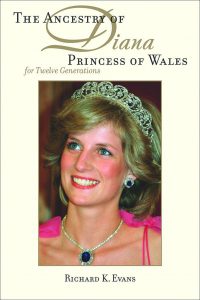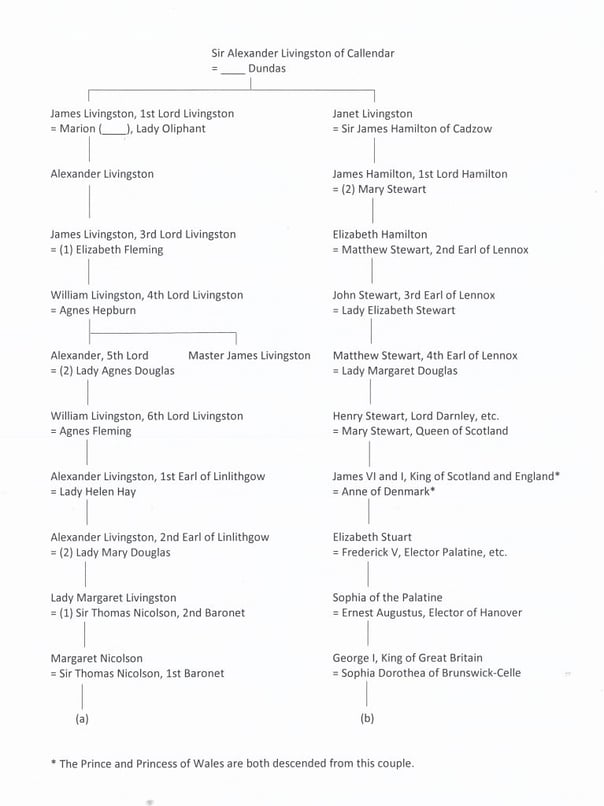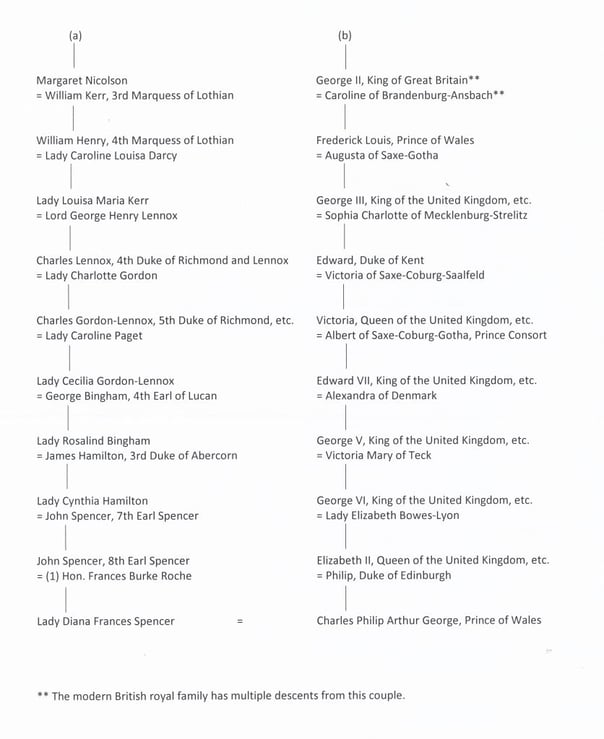 While working on the various connections of the Livingston family in Scotland, I had a vague recollection that I had encountered multiple Livingstons in the ancestry of the late Diana, Princess of Wales; several years ago I edited a book on her forebears,[1] and I pictured several lines from which to choose. The same, in a sense, must be true for the Prince of Wales, whose ancestry was covered so fully in Gerald Paget’s 1977 work.[2]
While working on the various connections of the Livingston family in Scotland, I had a vague recollection that I had encountered multiple Livingstons in the ancestry of the late Diana, Princess of Wales; several years ago I edited a book on her forebears,[1] and I pictured several lines from which to choose. The same, in a sense, must be true for the Prince of Wales, whose ancestry was covered so fully in Gerald Paget’s 1977 work.[2]
Well, yes and no. I suspect the name I sought was the Saltonstall family in the Princess’s ancestry – a family about whom I have written a book![3] The Saltonstalls appear with some frequency in The Ancestry of Diana, Princess of Wales, as we were careful to note the families in her ancestry with American connections. As for the Livingstons, there is a single line in the Princess’s ancestry from Alexander Livingston, 2nd Earl of Linlithgow, the great-great-nephew of Master James Livingston, forebear of the American Livingston family. The Prince of Wales has multiple Livingston lines, but from Sir Alexander Livingston of Callendar, father of the 1st Lord Livingston, grandfather of the 1st Lord Hamilton, and great-great-great-grandfather of Master James and his elder brother, the 5th Lord Livingston.
As so often in reviewing the ancestry of the Prince and Princess of Wales, one is struck by their ancestors’ knack for maintaining (and sometimes improving) their status. The 1st Lord Hamilton married the daughter of the King of Scotland; a great-grandson of this marriage married the half-sister of another King of Scotland (and the great-granddaughter of King Henry VII of England, through which the Stewart/Stuart family would claim the English throne); and the son of this last couple married the greatest prize of all: Mary, Queen of Scots (and Queen Dowager of France), whose life ended in another country, executed by her cousin – the Queen Elizabeth Mary’s son would succeed in 1603.
As so often in reviewing the ancestry of the Prince and Princess of Wales, one is struck by their ancestors’ knack for maintaining (and sometimes improving) their status.
While the senior line of the Linlithgow branch would weather the Stuart uprisings, ultimately losing their titles and estates (and, with the failure of the male line, become represented by the Earls of Erroll), the daughter of Lady Margaret Livingston married her first cousin. Their daughter married the Marquess of Lothian, and sons and daughters in subsequent generations married into other historic British families. The daughters married eldest sons, with titles and great estates; the sons married young women of similar background.
With King James VI and I, this line of Livingstons attained (and, generally, sustained) ruling power in the British Isles. By the end of the seventeenth century, the throne had passed (twice) via revolution; the peaceful succession in 1715 came at the cost of rejecting the claims of a number of heirs senior to the Hanover family. By now the mark of the ambitious Livingstons on the ancestry of the British royal family was faint indeed.
Nearly 600 years after Alexander Livingston of Callendar married a daughter of Dundas of Dundas, two of their descendants wed. At least via this accounting of their shared Livingston lines, the Prince and late Princess of Wales were nineteenth cousins. They were closer kin than that, via the Queen Mother, but it is still interesting to chart out their shared descent from an important figure in fifteenth-century Scotland, one with many descendants still be found in the United States.
Notes
[1] Richard K. Evans, The Ancestry of Diana, Princess of Wales, for Twelve Generations (Boston: New England Historic Genealogical Society, 2007).
[2] Gerald Paget, The Lineage and Ancestry of H.R.H. Prince Charles, Prince of Wales, 2 vols. (Edinburgh and London: Charles Skilton Ltd., 1977).
[3] Scott C. Steward, The Descendants of Dr. Nathaniel Saltonstall of Haverhill, Massachusetts (Boston: Newbury Street Press, 2013).
Share this:
About Scott C. Steward
Scott C. Steward has been NEHGS’ Editor-in-Chief since 2013. He is the author, co-author, or editor of genealogies of the Ayer, Le Roy, Lowell, Saltonstall, Thorndike, and Winthrop families. His articles have appeared in The New England Historical and Genealogical Register, NEXUS, New England Ancestors, American Ancestors, and The Pennsylvania Genealogical Magazine, and he has written book reviews for the Register, The New York Genealogical and Biographical Record, and the National Genealogical Society Quarterly.View all posts by Scott C. Steward →

